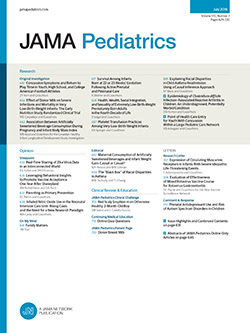早产新生儿产房复苏中肺通气相关的呼吸指标。
IF 18
1区 医学
Q1 PEDIATRICS
引用次数: 0
摘要
有效的肺通气对成功的产后过渡至关重要。早产儿在正压通气期间实现肺通气的目标指标尚未确定。目的探讨产房复苏中与肺通气成功相关的呼吸参数。设计、环境和参与者本多中心前瞻性队列研究于2016年3月至2021年4月进行。主要人群包括来自3个中心的22周至31周6天妊娠期心动过缓的早产儿,出生后复苏期间接受正压通气。在多中心监测新生儿复苏随机临床试验中,独立的早产儿人群(妊娠24周至27周6天)作为验证性数据集。数据分析时间为2022年1月至2025年5月。暴露量用呼吸功能监测仪(RFM)测量的滚动压力、吸气和呼气潮气量(VTE)和面罩泄漏量。在充气和取下面罩之间的自主呼吸次数。主要结局和措施主要结局是在复苏的前10分钟内心率持续增加到至少100次/分钟,表明有效的肺通气。临床协变量、呼吸参数和心率增加之间的关联使用原因特异性Cox比例风险回归模型进行检验。结果主要数据集中有132名新生儿(中位[IQR]妊娠,26.6[25.1-29.2]周;67例(50.8%)男性)和115例(中位[IQR]妊娠,26.7[25.6-27.4]周;65[56.5%]男性)。在132名主要数据集参与者中,125名(94.7%)达到了主要结局。在测量的呼吸参数中,只有VTE与心率增加相关(校正风险比[AHR], 1.10 [95% CI, 1.01-1.20])。VTE升高至4 mL/kg时AHR (AHR, 1.55 [95% CI, 1.20-2.00])高于VTE升高至4 mL/kg时AHR (AHR, 1.04 [95% CI, 0.98-1.10])。这些结果与验证性数据集中的结果一致:心率增加与VTE值高达4 mL/kg (AHR, 1.31 [95% CI, 1.01-1.70])相关,但不高于4 mL/kg (AHR, 1.02 [95% CI, 0.96-1.08])。与心率增加相关的其他协变量包括出生体重(每100克)(AHR, 1.12 [95% CI, 1.05-1.20])和面罩移除计数(AHR, 0.83 [95% CI, 0.70-0.98])。该队列研究在一组新生儿人群中观察到,并在另一组人群中证实,在早产新生儿复苏期间,通过心率增加到至少每分钟100次来评估,最低VTE为4 mL/kg与肺通气成功相关。这些结果可能为未来的研究提供信息,以确定将基于数据的目标纳入产房早产儿复苏的临床影响。本文章由计算机程序翻译,如有差异,请以英文原文为准。
Respiratory Targets Associated With Lung Aeration During Delivery Room Resuscitation of Preterm Neonates.
Importance
Effective lung aeration is crucial for successful postnatal transition. Goal targets to achieve lung aeration during positive pressure ventilation have not been established for preterm neonates.
Objective
To identify respiratory parameters associated with successful lung aeration during delivery room resuscitation.
Design, Setting, and Participants
This multicenter prospective cohort study was conducted from March 2016 to April 2021. The primary population included preterm neonates from 3 centers of 22 weeks to 31 weeks 6 days' gestation with bradycardia who received positive pressure ventilation during resuscitation after birth. An independent population of preterm neonates (24 weeks to 27 weeks 6 days' gestation) in the multicenter Monitoring Neonatal Resuscitation randomized clinical trial served as a confirmatory dataset. Data were analyzed January 2022 to May 2025.
Exposures
Rolling means of pressure, inspiratory and expiratory tidal volumes (VTE), and mask leak, as measured with a respiratory function monitor (RFM). Counts of spontaneous breaths between inflations and mask removal instances.
Main Outcomes and Measures
The primary outcome was a sustained increase in heart rate to at least 100 beats per minute, indicating effective lung aeration, within the first 10 minutes of resuscitation. Associations between clinical covariates, respiratory parameters, and heart rate increase were examined using cause-specific Cox proportional hazards regression models.
Results
There were 132 neonates in the primary dataset (median [IQR] gestation, 26.6 [25.1-29.2] weeks; 67 [50.8%] male) and 115 in the confirmatory dataset (median [IQR] gestation, 26.7 [25.6-27.4] weeks; 65 [56.5%] male). Of 132 primary dataset participants, 125 (94.7%) achieved the primary outcome. Among the measured respiratory parameters, only VTE was associated with an increase in heart rate (adjusted hazard ratio [AHR], 1.10 [95% CI, 1.01-1.20]). The AHR was higher for increases in VTE up to 4 mL/kg (AHR, 1.55 [95% CI, 1.20-2.00]) than for VTEs higher than 4 mL/kg (AHR, 1.04 [95% CI, 0.98-1.10]). These results were consistent with those in the confirmatory dataset: an association for an increase in heart rate with VTE values up to 4 mL/kg (AHR, 1.31 [95% CI, 1.01-1.70]) but not higher than 4 mL/kg (AHR, 1.02 [95% CI, 0.96-1.08]). Other covariates associated with an increase in heart rate included birth weight (per 100 g) (AHR, 1.12 [95% CI, 1.05-1.20]) and mask removal count (AHR, 0.83 [95% CI, 0.70-0.98]).
Conclusions and Relevance
This cohort study observed in one neonatal population and confirmed in another that a minimum VTE of 4 mL/kg was associated with successful lung aeration as assessed by an increase in heart rate to at least 100 beats per minute during preterm neonate resuscitation. These results may inform future studies to determine the clinical impact of incorporating data-based targets for delivery room resuscitation of preterm neonates.
求助全文
通过发布文献求助,成功后即可免费获取论文全文。
去求助
来源期刊

JAMA Pediatrics
PEDIATRICS-
CiteScore
31.60
自引率
1.90%
发文量
357
期刊介绍:
JAMA Pediatrics, the oldest continuously published pediatric journal in the US since 1911, is an international peer-reviewed publication and a part of the JAMA Network. Published weekly online and in 12 issues annually, it garners over 8.4 million article views and downloads yearly. All research articles become freely accessible online after 12 months without any author fees, and through the WHO's HINARI program, the online version is accessible to institutions in developing countries.
With a focus on advancing the health of infants, children, and adolescents, JAMA Pediatrics serves as a platform for discussing crucial issues and policies in child and adolescent health care. Leveraging the latest technology, it ensures timely access to information for its readers worldwide.
 求助内容:
求助内容: 应助结果提醒方式:
应助结果提醒方式:


